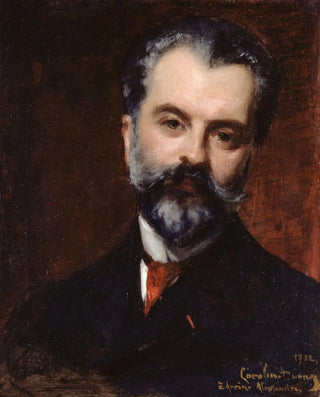Art print | Portrait of Arsène Alexandre 1859-1935 art historian and critic - Carolus-Duran


View from behind

Frame (optional)
Portrait of Arsène Alexandre 1859-1935 art historian and critic - Carolus-Duran – Engaging Introduction
In the vibrant world of art, some works transcend their era to become timeless witnesses of thought and culture. The "Portrait of Arsène Alexandre" by Carolus-Duran perfectly fits this category. Created in 1890, this painting is not merely a depiction of a man but a tribute to the intellect and passion of an eminent art critic. Arsène Alexandre, an art historian, captured the essence of the artistic movements of his time, and his portrait by Duran offers a fascinating gateway into this universe. The way the artist immortalized the penetrating gaze and commanding presence of Alexandre invites us to reflect on the very nature of art and critique.
Style and uniqueness of the work
Carolus-Duran's style stands out for its ability to blend academic tradition with a more modern approach. In this portrait, the finesse of the painting technique is evident. The brushstrokes, both precise and fluid, give life and vibrancy to the subject. The light, skillfully orchestrated, highlights the features of Alexandre's face while creating an intimate atmosphere. The carefully chosen colors evoke a rich and nuanced palette, emphasizing the psychological depth of the character. This portrait does not merely freeze a moment; it captures an essence, a personality, reminding us that behind every piece of art lies a story, a passion, a commitment.
The artist and his influence
Carolus-Duran, whose real name is Charles Émile Auguste Durand, is an iconic figure of French art at the end of the 19th century. Influenced by the masters of the past, he developed a style that is uniquely his own, combining realism and impressionism. Duran not only marked his time with his paintings but also through his role as a teacher, training many artists who would become major figures of modern art. His friendship with personalities like Arsène Alexandre reflects the interconnectedness between artists and critics of the era. By painting Alexandre, Duran does not merely

Matte finish

View from behind

Frame (optional)
Portrait of Arsène Alexandre 1859-1935 art historian and critic - Carolus-Duran – Engaging Introduction
In the vibrant world of art, some works transcend their era to become timeless witnesses of thought and culture. The "Portrait of Arsène Alexandre" by Carolus-Duran perfectly fits this category. Created in 1890, this painting is not merely a depiction of a man but a tribute to the intellect and passion of an eminent art critic. Arsène Alexandre, an art historian, captured the essence of the artistic movements of his time, and his portrait by Duran offers a fascinating gateway into this universe. The way the artist immortalized the penetrating gaze and commanding presence of Alexandre invites us to reflect on the very nature of art and critique.
Style and uniqueness of the work
Carolus-Duran's style stands out for its ability to blend academic tradition with a more modern approach. In this portrait, the finesse of the painting technique is evident. The brushstrokes, both precise and fluid, give life and vibrancy to the subject. The light, skillfully orchestrated, highlights the features of Alexandre's face while creating an intimate atmosphere. The carefully chosen colors evoke a rich and nuanced palette, emphasizing the psychological depth of the character. This portrait does not merely freeze a moment; it captures an essence, a personality, reminding us that behind every piece of art lies a story, a passion, a commitment.
The artist and his influence
Carolus-Duran, whose real name is Charles Émile Auguste Durand, is an iconic figure of French art at the end of the 19th century. Influenced by the masters of the past, he developed a style that is uniquely his own, combining realism and impressionism. Duran not only marked his time with his paintings but also through his role as a teacher, training many artists who would become major figures of modern art. His friendship with personalities like Arsène Alexandre reflects the interconnectedness between artists and critics of the era. By painting Alexandre, Duran does not merely






